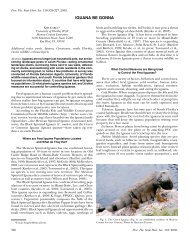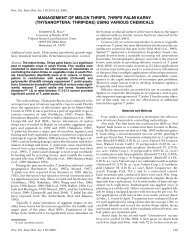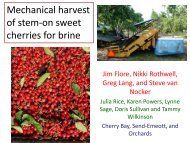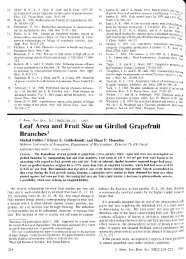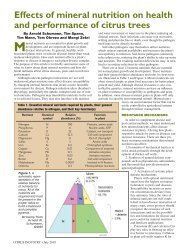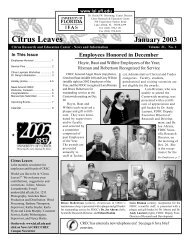Mechanical Harvesting of Fruit
Mechanical Harvesting of Fruit
Mechanical Harvesting of Fruit
You also want an ePaper? Increase the reach of your titles
YUMPU automatically turns print PDFs into web optimized ePapers that Google loves.
Mechanized <strong>Fruit</strong> <strong>Harvesting</strong><br />
Past achievements, Current<br />
Status and Future Prospects<br />
Yoav Sarig, Pr<strong>of</strong>. Emeritus<br />
The Institute <strong>of</strong> Agric. Eng.<br />
Agric. Res. Org.<br />
P.O. Box 6, Bet Dagan, Israel
Presentation layout<br />
� Introduction – background &<br />
statement <strong>of</strong> the problem<br />
� Objectives<br />
� The scope <strong>of</strong> mechanical harvesting<br />
a) Labor aids<br />
b) Labor saving machines<br />
c) Robotic fruit harvesting<br />
� Site-Specific solutions<br />
� Conclusions<br />
2
Objectives<br />
� To briefly describe the currently available<br />
technologies – advantages & drawbacks and<br />
suggest that no single solution is applicable<br />
� To propose a course <strong>of</strong> action, which should be<br />
taken by industry – both growers &<br />
equipment manufacturers, in order to<br />
maintain the viability and competitiveness <strong>of</strong><br />
the fruit industry<br />
3
This presentation doesn’t purport<br />
to report on new technological<br />
breakthroughs<br />
Rather, it attempts to provide a<br />
different thinking on the complex<br />
process <strong>of</strong> fruit harvesting,<br />
contributing, hopefully, to its<br />
optimization
Statement <strong>of</strong> the problem<br />
5
<strong>Fruit</strong> growers in the developed<br />
countries are facing two significant<br />
problems that could determine the<br />
future <strong>of</strong> their business:<br />
•Lack <strong>of</strong> adequate labor supply<br />
•Competitiveness in the global<br />
market<br />
Can’t we solve these problems?
Back in the 70`s there was a<br />
commercial on the U.S TV:<br />
“They can send a man to the<br />
moon, how come they can’t<br />
make a good c<strong>of</strong>fee?”<br />
7
Paraphrasing on this<br />
commercial:<br />
The developed countries have advanced<br />
technologies in many areas, but fruits, for<br />
the most part, are still being picked by<br />
hands, worldwide.<br />
Why is it that no mechanical solution is yet<br />
available for harvesting fresh<br />
fruit?<br />
8
The reason is simple:<br />
Rather than make investments in<br />
new technologies, farmers,<br />
worldwide, mostly focused on<br />
lobbying governments for easier<br />
access to inexpensive labor –<br />
and succeeded!<br />
9
The result:<br />
The cheap labor that mass immigration<br />
provided in countries such as the U.S.,<br />
Germany, France, Israel, Spain and<br />
others, has blocked any incentive to<br />
develop mechanical systems to replace<br />
manual labor.<br />
The end result is that at present these<br />
countries are in a disadvantage position in<br />
the face <strong>of</strong> global competition<br />
10
Ironic, but sad:<br />
The cheap, mainly illegal labor<br />
immigrants are becoming<br />
unpr<strong>of</strong>itable with the<br />
competition from even cheaper<br />
labor in less developed<br />
countries!<br />
11
The conclusions:<br />
� Farmers in developed countries can’t<br />
ignore any more technological<br />
improvements and the need for<br />
investments.<br />
� Competing on low labor costs is infeasible<br />
� To stay in business means reducing costs<br />
– the only viable way to do that is through<br />
mechanization<br />
12
While mechanization is recognized as<br />
the major vehicle for reducing the cost<br />
and the only mean to stay competitive,<br />
it is important to note that in addition:<br />
� Mechanization reduces the farmer’s drudgery and<br />
improves his ability to perform operations in a<br />
timely matter<br />
� Reduces the risks associated with need for large<br />
amounts <strong>of</strong> seasonal labor for short periods <strong>of</strong> time<br />
� Lessens the social problems which accompany<br />
excessive influx <strong>of</strong> low-wage workers<br />
� Has the ability to potentially reduce human contact<br />
with food (food safety)<br />
13
In spite <strong>of</strong> the complexity <strong>of</strong> the<br />
problem there are, nevertheless<br />
quite some cases <strong>of</strong> success that<br />
are already in commercial use<br />
14
Past Achievements<br />
15
Few examples <strong>of</strong> a successful<br />
mechanical harvesting<br />
16
Unfortunately, after 60 years <strong>of</strong> R&D,<br />
the harvesting <strong>of</strong> 25 fruit crops still<br />
has not been mechanized<br />
17
However, apple, pear, apricot,<br />
peach, mango, avocado,<br />
litchi, kiwi, olives, sweet<br />
cherries - few examples <strong>of</strong><br />
fruit crops which are still<br />
being hand picked!
Admittedly, not all harvesting<br />
situations are amenable (yet) to<br />
mechanization<br />
But, unfortunately, even those<br />
solutions which are available are<br />
only partially employed, and in<br />
many cases their use is not<br />
justified economically!<br />
19
Moreover!<br />
� Many <strong>of</strong> the growers (regardless <strong>of</strong> the<br />
country) are not well informed <strong>of</strong> what is<br />
being done to mechanize fruit harvesting<br />
outside their perimeter – both<br />
domestically and internationally!<br />
� There is not enough awareness with<br />
regard to the need to adapt the orchard<br />
characteristics – size, shape, tree spacing,<br />
in a comprehensive system approach to<br />
optimize the harvesting<br />
20
Ever since Eve<br />
has reached<br />
out to pick the<br />
apple in Eden,<br />
attempts are<br />
being made to<br />
develop better<br />
methods for<br />
harvesting<br />
fruit<br />
21
There are basically three modes<br />
<strong>of</strong> harvest mechanization<br />
Labor-aids<br />
Labor saving machines<br />
Robotics & Automation<br />
22
Labor-Aids<br />
Labor-aids are aimed at<br />
reducing the drudgery <strong>of</strong><br />
farm labor by reducing the<br />
effort and endurance<br />
required for the fruit-<br />
picking operation
The ladder-the basic<br />
picking-aid<br />
24
A 4 workers articulated picking-<br />
aid<br />
25
Advantages:<br />
Picking-aids increase the supply <strong>of</strong><br />
labor, reduce seasonal demands,<br />
stabilize the labor force and<br />
increase the potential <strong>of</strong> pool <strong>of</strong><br />
laborers by improving working<br />
conditions
Disadvantages:<br />
�None <strong>of</strong> the picking-aids makes the<br />
harvesting competitive with<br />
standard methods and thus, their<br />
use is not justified economically!<br />
�As long as picking is done<br />
manually, the potential for<br />
increasing productivity is limited 27
Labor-saving machines<br />
Main characteristics:<br />
their ability to remove<br />
fruits in multiples (mass<br />
harvesting)
Mass-harvesting <strong>of</strong> grapefruit<br />
(Israel)<br />
29
Mass-harvesting system for<br />
olives for oil (Italy)<br />
30
An experimental harvester for<br />
jojoba (Israel)<br />
31
Shake & Catch System for<br />
<strong>Harvesting</strong> Oranges (U.S)<br />
32
<strong>Mechanical</strong> harvester for<br />
wine-grapes (France)<br />
33
A shake & catch system for<br />
harvesting appricot & cling<br />
peaches (the U.S.)<br />
34
Major advantages:<br />
� This class <strong>of</strong> equipment <strong>of</strong>fers a<br />
significant increase in harvest labor<br />
productivity – with some crops a 100<br />
fold increase in productivity has been<br />
recorded!<br />
� Thus, these machines have the<br />
potential to meet the objective <strong>of</strong><br />
reducing total harvesting costs<br />
35
Disadvantages<br />
� The major deterrent to the introduction<br />
<strong>of</strong> labor-saving machines is the excessive<br />
mechanical damage incurred during<br />
mechanical harvest.<br />
� Thus, although productivity can be<br />
increased significantly, the commercial<br />
implementation <strong>of</strong> labor-saving machines<br />
is limited to fruit which are destined for<br />
processing (such as olives), or are not<br />
prone to mechanical damage (nut crops)<br />
36
Robotic <strong>Fruit</strong> <strong>Harvesting</strong><br />
37
Robotic fruit harvesting aims to automate<br />
the fruit picking process by using a system<br />
that emulate the human picker for decision<br />
making and picking. Conceptually, it<br />
should provide the same, or better quality,<br />
at a much faster rate<br />
38
Robotic harvesting<br />
Examples <strong>of</strong> Engineering Concepts<br />
39
Robotic harvesting should provide,<br />
in principle, the only solution for<br />
substituting manual labor for<br />
picking perishable fruit destined for<br />
the fresh market<br />
� Unfortunately, although remarkable and<br />
encouraging results have been already<br />
obtained (with apple & citrus), robotic<br />
harvesting is yet not feasible and can’t be<br />
considered as a competitive solution<br />
40
The current status <strong>of</strong><br />
harvest mechanization<br />
worldwide<br />
41
Labor-aids<br />
� Are widely used in Italy, where typically many small<br />
manufacturers build their own version <strong>of</strong> a highlifting<br />
platform<br />
� Are used in Australia<br />
mostly imported designs<br />
� Are quite common in Israel (<strong>of</strong> local design), but used<br />
mostly on tall trees (avocado, dates)<br />
� Are used, to some extent in the U.S. Spain, France<br />
and other fruit-producing countries in Europe<br />
� Special design <strong>of</strong> labor-aids have been<br />
developed and used in the Netherlands 42
Labor-saving machines<br />
� Are currently used for harvesting all nut crops,<br />
<strong>Mechanical</strong> harvesting <strong>of</strong> wine grapes (U.S.,<br />
France, Italy, Spain, Australia, South Africa &<br />
Israel)<br />
� <strong>Mechanical</strong> harvesting <strong>of</strong> c<strong>of</strong>fee (Brazil)<br />
� <strong>Mechanical</strong> harvesting <strong>of</strong> olives for oil (Italy,<br />
Spain, Israel, Argentina, U.S.)<br />
� <strong>Mechanical</strong> harvesting <strong>of</strong> prunes, citrus fruit<br />
peaces & tart cherries destined for processing<br />
(U.S.)<br />
43
Robotic harvesting systems<br />
- None is being used commercially at<br />
present<br />
- In the past – work in the U.S., France,<br />
Spain, Italy, Hungary, Israel & Japan<br />
- Present R&D work continues in Japan.<br />
- Work has also commenced in Holland<br />
and Australia & a renewed work in the<br />
U.S.
In spite <strong>of</strong> the tremendous R&D work<br />
in more than 60 years <strong>of</strong> research, a<br />
commercial use <strong>of</strong> harvest machinery<br />
has been only partially implemented<br />
and is not viable yet, for fresh fruit<br />
crops<br />
Is it really a no-win<br />
situation?
WE STATE CATEGORICALLY<br />
THAT MAINTAINING<br />
COMPETITIVENESS IS FEASIBLE!<br />
However, to reach this goal is<br />
not easy, especially with fruit<br />
destined for fresh consumption,<br />
which presents a major<br />
challenge
What direction should the<br />
industry take?<br />
47
Because <strong>of</strong> the complexity <strong>of</strong> the<br />
harvesting operation, the diversity <strong>of</strong><br />
the fruit crops and growing conditions,<br />
a system approach should be adopted<br />
� Within this approach we propose that<br />
all available solutions should be<br />
evaluated on the basis <strong>of</strong> “ site-specific<br />
solutions” to yield the optimal solution<br />
for a given harvesting situation<br />
48
A few examples to<br />
illustrate the concept <strong>of</strong><br />
“Site-specific Solutions”<br />
49
A picking-aid system for picking<br />
peaches in a semi-dwarf orchard<br />
50
A continuous moving picking-aid<br />
53
<strong>Mechanical</strong> harvesting <strong>of</strong><br />
peaches in a meadow orchard<br />
54
<strong>Mechanical</strong> harvesting <strong>of</strong> olives<br />
for oil<br />
55
A mechanize harvesting system for<br />
citrus destined for processing<br />
(in Florida)<br />
56
<strong>Harvesting</strong> dates<br />
(in Israel)<br />
57
Mass-harvesting <strong>of</strong> dates<br />
58
In addition we propose:<br />
� Changing orchard characteristics –size,<br />
shape, tree spacing and varietals changes<br />
to make it amenable to mechanical<br />
harvesting<br />
� Introducing mechanical solutions to<br />
reduce mechanical damage and sorting<br />
systems to sort out damaged fruit<br />
� Developing economical viable robotic<br />
harvesting systems, substituting manual<br />
labor for harvesting fresh-market fruit<br />
59
The challenge is big!<br />
Will the industry rise to meet the<br />
challenge?<br />
60



